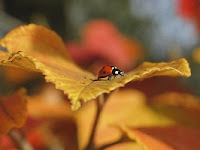You may think that the worst of your insect worries are gone now that we are heading to winter; I’d like to suggest that you reconsider that notion. Late fall and early winter bring a whole slew of new characters into play and these insect pests can be just as pesky and potentially dangerous as those warm weather bugs. With the extreme weather predicted for much of the US in the next week, the time to address pests is now.

 |
| Stink bugs on a pumpkin |
 Not all insect pests are as obvious as those mentioned above, many find ways to smuggle themselves into the cozy confines of your home. Before you dig out those boxes of winter clothing, oversized platters for Thanksgiving or trunks of Christmas ornaments, consider what you may be bringing into your home with them. Give everything a quick inspection before moving or relocating it. The following are some useful steps to avoid transporting unwelcome guests:
Not all insect pests are as obvious as those mentioned above, many find ways to smuggle themselves into the cozy confines of your home. Before you dig out those boxes of winter clothing, oversized platters for Thanksgiving or trunks of Christmas ornaments, consider what you may be bringing into your home with them. Give everything a quick inspection before moving or relocating it. The following are some useful steps to avoid transporting unwelcome guests:Store firewood at least three feet from your house. It may mean a chilly wood retrieval trip, but it will deter insects from making that same chilly jaunt into the house. If it’s placed too close to or up against the house, you give burrowing pests a platform to get busy on your brick or woodwork. If you can keep it off the ground, that's even better. It will make the wood less accessible to termites and other soil-dwelling pests. Once you bring the wood inside, use it within 48 hours; storing it any longer can just encourage already-inside pests to set up house.
Pantry pests can arrive to your home in groceries and other packages. During the holidays we bring a lot of this inside. Shake out all bags before storing them or putting them in your trash can. Just as their name indicates, pantry pests can happily live in pantries and other storage. If you head down into the cellar or out to the garage to fetch some of the goodies you put up in the summer, keep an eye out for anything that may be nesting there (or attaching itself to your clothing to get inside). Here are some products that can help with these type of pests.
Standing water is an insect magnet. Eliminate it inside and out. There does not have to be much for an insect to take an interest – even the condensation from an appliance is enough.
 Recycling and trash bins in garages, attached to or too close to the house can also be insect beacons. Move them away from the house and keep them as clean as possible. Ants, especially, can go undetected until they use a scent trail to call in their whole colony. Then you’ve got a fight on your hands.
Recycling and trash bins in garages, attached to or too close to the house can also be insect beacons. Move them away from the house and keep them as clean as possible. Ants, especially, can go undetected until they use a scent trail to call in their whole colony. Then you’ve got a fight on your hands.This is an excellent time of year to remove debris and cut back branches that make contact with your house. It is an easy insect commute from the branch to the house.
Now, let’s talk Christmas trees: Some people are never-plastic tree people and others are diehard artificialists. If you are still in the middle and insects give you the creeps, you may want to go fake. There are many insects commonly found on and in trees that will dislodge themselves and try to make your nice, warm home their nice warm home. It is a common practice for the Christmas tree industry to spray highly toxic insecticides (although many are moving away from this) on their trees, but this spraying takes place in the spring and summer; it is quite possible for insects to find their way back in before Christmas. Some tree lots have shakers, which aim to dislodge any intruders, but I wouldn’t depend on that too much as many pests will be inside the bark holding on tightly. If you are taking a tree from the forest, you are quite likely bringing home more than memories. A small, live tree that you can easily inspect for pests is the surest way to get an insect-free evergreen. Plus, when you plant it outside after the holiday, you are doing a small favor to the environment. This article lists some of the more common Christmas tree pests (a tree can have 25,000 bugs!), how to stop them and some preventative measures you can take before bringing the tree in. They recommend Diatomaceous Earth and Neem Oil-based sprays, which we have here and here. In some part of the country, there is a real worry that the invasive Spotted Lanternfly may be spread through Christmas trees. Read more about that here.

There are, of course, mammal pests that wiggle their way into homes. Rodents of all kinds prefer a toasty house to a drafty den. But, if you take the steps to seal and protect your home from insects, you will be doing a great deal to discourage furry intruders as well.
Stay warm and pest free (not counting relatives)!
Submitted by Pam








No comments:
Post a Comment